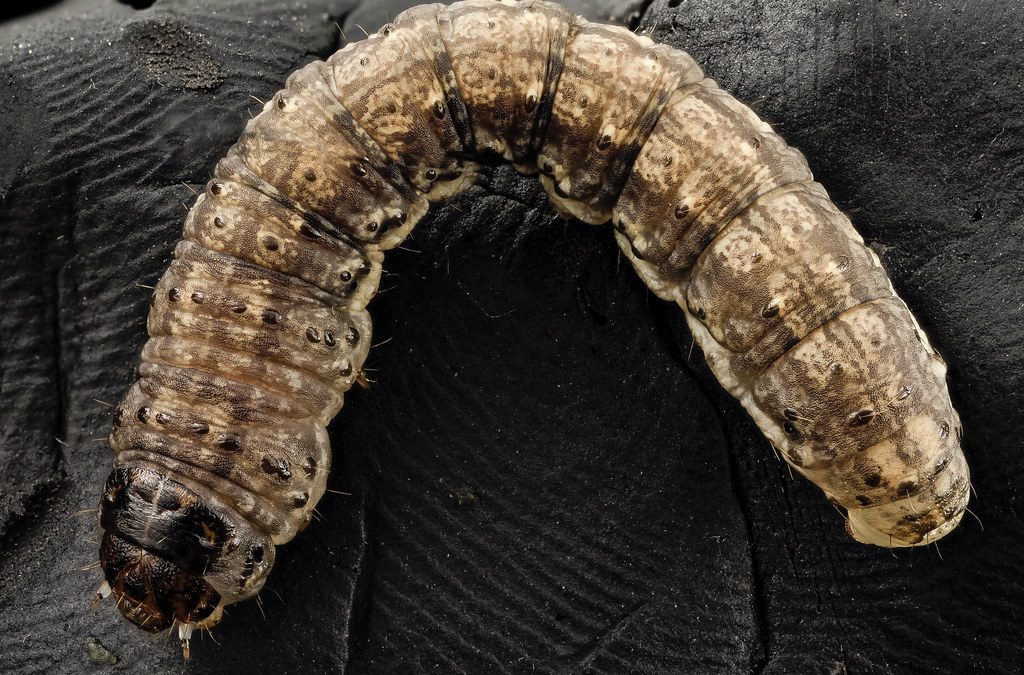Twin Cities gardeners hate any backyard bugs that destroy lawns and gardens. But some of those pests will wreak more damage than others. It’s time to put away that “Minnesota nice” and get tough on the insect invaders. Here are some of the worst backyard pests in Minneapolis — and tips on how to get rid of them.
Cutworms
Cutworms (pictured above) aren’t really worms. They’re caterpillars that will turn into several different species of the Noctuidae moth if left alone. The adult moths don’t do any damage. It’s the cutworms in their larval stage that feed on buds, shoots, and leaves, and wreak havoc in your garden. Some prefer your vegetable garden, while other species will damage the lawn. Cutworms get about 2 inches long and curl up into a tight “C” shape if you bother them.
You can pick them off your plants by hand and drop them into a bucket of soapy water. Consider adding some beneficial nematodes to your garden to devour the cutworm eggs. You can prevent them from invading your garden by maintaining a 3-foot buffer of dry soil around the edge of your garden. Make sure your yard is well weeded, so cutworms don’t feed on the weeds. And till your plots before planting — it will expose and kill the cutworms long before they can do any damage.
Japanese Beetles
If you spot iridescent green beetles in your vegetable patch, you’ve got Japanese beetles. The Japanese beetle is an invasive species that was accidentally introduced to the U.S. in the early 20th century. Today they’re a major backyard pest in the Midwest and on the East Coast. They attack in groups, damaging plants. Even if you don’t see the beetle itself, you can tell they’ve moved in when they’ve eaten your plants down to the veins. They can also cause brown patches in your lawn.
One of the most effective ways to get rid of Japanese beetles is to handpick them. Drop them into a mixture of dish detergent and water, and they will drown. Or put a drop cloth underneath the plants and shake them off. Then, drown them in the detergent water. You can also spray neem oil or potassium bicarbonate on affected plants. This will kill the eggs laid by the adult beetles. There are also commercial pesticides available for sale at your local garden store that will kill Japanese beetles.
Carpenter Ants
You’ll be glad to know that termites aren’t common in Minneapolis. But carpenter ants are a problem, and if you see ants burrowing into an old stump, or log, or your deck, they could be getting inside your home. Like termites, carpenter ants do some costly damage, eating away at the foundation of your house.
You’ll need to call a professional pest removal company to get rid of these buggers. This isn’t the time to try DIY pest control. Some bug sprays can make the problem worse since carpenter ants have several colonies and queens. But you can help yourself out by removing any stumps, logs or old wood near your home, and cut back any branches or bushes from touching your home. Also, make sure you stack firewood away from the walls of your home and inspect any firewood you bring inside.
Bluegrass Billbug
The bluegrass billbug likes Kentucky bluegrass, as the name suggests. You’ll know you have a problem when you spot irregularly shaped patches of grass that turn yellow, and then brown. The damaged grass can be pulled out easily because the insects weaken the roots. Damage from this backyard pest becomes apparent around July.
You can squeeze the billbug infestation out by making your grass healthier. That means keeping up moisture levels and nutrients, to reduce stress. Lawn experts don’t recommend pesticides for these pests, because the chemicals also kill beneficial bugs and parasites that keep the billbug population in check. However, an application of insect parasitic nematodes might control the infestation. If the infestation is too severe, consider laying down pesticides the following spring.
Iris Borers
This caterpillar will destroy your irises. Iris borers chew holes in the leaves and then tunnel through the plant all the way down into the rhizome, the underground runner that is the prize this pest is after. You can spot the iris borer in the spring, by looking for signs of chewed up leaves, or streaks. In the summer, after the caterpillar makes its way down to the rhizome, you’ll see brown-tipped leaves.
If you find them in the spring, you can simply crush the caterpillar while it’s inside the iris leaf, or pick the affected leaves. But if you suspect iris borers later in the season, you need to dig it up and inspect the rhizome. If you see signs of tunneling or the caterpillars themselves, toss the rhizome in the trash. In the fall, after the iris season is over, experts recommend you remove and burn any plants afflicted with the pest. And clean up the iris beds after a hard frost. If you use a pesticide, apply it immediately after the eggs hatch — very early in the spring.
Fighting the worst backyard pests in Minneapolis can be a time-consuming job. But it’s easier to treat the problem before the damage becomes severe. The difficult part is knowing which pests are damaging which plants. Once you’ve identified the enemy, it will easier to fight it.
Looking for more lawn care information and tips? Be sure to check our Minneapolis lawn care page.

